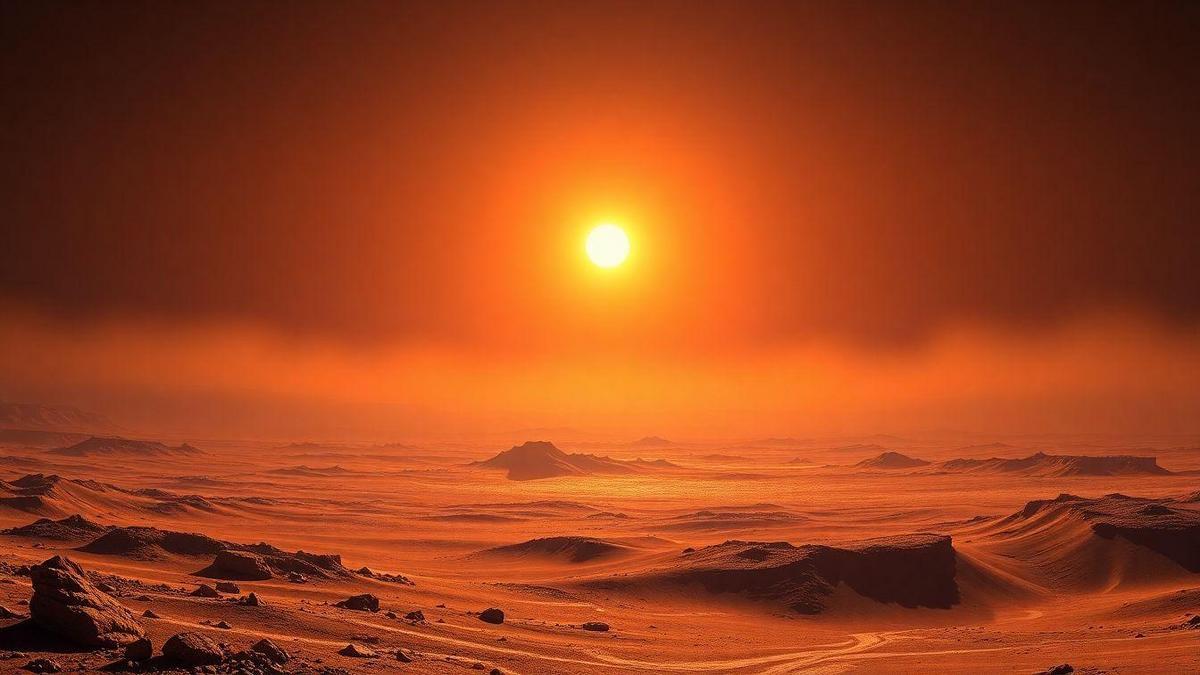
Dust storms on Mars are atmospheric phenomena that have intrigued scientists and space enthusiasts for decades. These storms vary in intensity and duration, affecting the surface of the Red Planet and the success of exploration missions. Understanding these events is crucial for the future of Mars exploration, as they directly impact the operation of rovers, orbiters, and future crewed missions.
In addition, dust storms on Mars have significant implications for the planet’s climatology and geology. They offer insights into Mars’s atmospheric history and its climatic changes over millennia. Studying these storms is essential for preparing future missions aimed at colonizing or studying Mars in depth.
How Dust Storms on Mars Work
Dust storms on Mars are triggered by a combination of atmospheric and geological factors. Mars’s atmosphere is composed primarily of carbon dioxide, and while it is much thinner than Earth’s, it can still generate strong winds. These winds lift fine dust particles from the surface, creating clouds that can spread across vast areas. Solar heating also plays a crucial role, as temperature differences between day and night intensify air currents, contributing to storm formation.
A remarkable feature of Martian dust storms is their scale. They may begin in small regions but can sometimes expand to envelop the entire planet—a phenomenon known as a global dust storm. During these storms, visibility at the surface can drop drastically, and the dust can remain suspended in the atmosphere for weeks or even months, affecting both temperature and atmospheric dynamics.
Dust storms on Mars also follow a seasonal cycle, occurring more frequently during the spring and summer in each hemisphere. These periods are marked by increased solar radiation, which heats the surface and drives air movement. The interaction between rising dust and sunlight can create a positive feedback loop—more dust means more heat, which intensifies the storm.
The composition of Martian dust also influences storm dynamics. The dust is made mostly of fine mineral particles, such as iron oxides, which can absorb and reflect sunlight in different ways. This interaction with solar energy not only affects atmospheric temperatures but also has implications for atmospheric chemistry and cloud formation. Therefore, understanding how these storms work is essential for predicting their effects and preparing future exploration missions.

Advantages of Understanding Dust Storms on Mars and Their Impacts
Understanding dust storms on Mars brings significant advantages to planetary exploration. This knowledge allows scientists and engineers to better plan space missions. By anticipating adverse weather conditions, mission teams can adjust schedules and rover objectives, ensuring that critical operations are performed during favorable conditions.
Furthermore, knowledge of Martian dust storms helps protect surface equipment. Rovers and other devices are built to withstand extreme conditions, but storms can cause unexpected damage, such as covering solar panels. Knowing the frequency and intensity of these storms allows for preventive measures, such as scheduling “hibernation” periods for rovers during severe events.
Another benefit of studying Martian dust storms is a deeper understanding of Mars’s atmosphere. Storms play a crucial role in atmospheric dynamics and climate. By analyzing how these storms form and dissipate, scientists gain insights into Mars’s climatic history—including changes that have occurred over billions of years. This knowledge is key to determining whether Mars once had conditions suitable for life.
Finally, research into Martian dust storms is vital for the future of human exploration. As we approach the possibility of crewed missions to Mars, it’s essential to understand how storms may affect astronaut safety and daily operations. Understanding storm dynamics will allow mission planners to develop strategies to protect astronauts and ensure mission continuity on the Martian surface.
How Dust Storms on Mars Affect Space Exploration
Dust storms on Mars have a major impact on space exploration, affecting both robotic operations and scientific data collection. During a storm, surface visibility can drop dramatically, making navigation and exploration by rovers much more difficult. This can delay missions and data collection—especially considering the limited time rovers have to operate on Mars.
In addition, Martian dust storms can interfere with communication between rovers and mission control on Earth. The suspended dust can disrupt radio signals, making data transmission and remote control more challenging. Mission teams must therefore develop strategies to minimize the impact on communication, such as using redundant communication systems or scheduling downtime during intense storms.
Another important issue is the effect of storms on solar-powered rovers. Many Mars vehicles rely on solar panels for energy. During a storm, dust can cover these panels, reducing their efficiency and, in some cases, leading to complete energy loss. To address this problem, rovers must be designed with dust-clearing systems or programmed to enter hibernation mode until the storm subsides and sunlight returns.
Lastly, research into Martian dust storms is essential for preparing future human missions. Storms may pose serious risks to astronaut health and safety—especially during extravehicular activities (EVAs). Therefore, knowing when and how these storms occur is crucial to mission planning, ensuring that astronauts can operate safely and effectively in such a challenging environment.
-
Continuous monitoring: Using orbiters and satellites to monitor dust storms on Mars in real time.
-
Technology development: Designing protective technologies for rovers and human habitats against dust.
-
Mission planning: Adjusting launch windows and operations based on storm forecasts.
-
Team training: Preparing mission control teams to respond to dust storm events.
-
Data collection: Implementing methods to collect data even during storms, such as robust sensor systems.
-
Lab simulations: Conducting laboratory simulations of dust storms to test equipment durability.
Understanding how dust storms affect space exploration is essential for ensuring the success of future missions. With proper preparation and planning, risks can be minimized, and opportunities for exploration and discovery maximized.

Did You Enjoy Learning More About Dust Storms on Mars?
Dust storms on Mars are far more than just dramatic weather events—they are key elements in understanding the Red Planet’s past, present, and future. Exploring how these storms arise, how they behave, and what effects they have on the Martian environment gives us critical insights into planetary science, atmospheric dynamics, and the practical challenges of conducting missions on Mars.
By studying dust storms, scientists can trace back the history of Mars’s climate, revealing patterns of change that may explain how the planet transformed from a once wetter and potentially habitable world into the dry, dusty desert we see today. These storms not only shape the Martian surface but also influence how heat, particles, and gases move through the atmosphere—data that is essential for modeling the planet’s climate and preparing for future human presence.
Understanding Martian dust storms is also vital for mission safety and engineering. From the loss of solar power in robotic explorers like Opportunity, to the potential hazards they pose to astronauts’ habitats and equipment, these storms are not just obstacles—they are design challenges. The more we know about them, the better we can build resilient systems and plan operations that take advantage of the calm before, during, or after the storm.
For space agencies and researchers around the world, Mars remains a primary focus of planetary exploration, and dust storms are one of its most unpredictable and powerful natural forces.
Frequently Asked Questions
What are dust storms on Mars?
They are events that lift dust from the Martian surface, covering large areas of the planet.
How common are these storms?
They occur frequently, especially during Martian spring, and can last for weeks.
How do dust storms affect robots on Mars?
The storms reduce sunlight, which makes it harder for solar-powered robots like Curiosity and Perseverance to operate.
What impact do dust storms have on scientific research?
Dust storms can interfere with data collection, making it more difficult to study Mars and its climate.
How will astronauts deal with dust storms in the future?
Astronauts will need special protection and shelters to stay safe during dust storms on Mars.

